
Hypleurochilus springeri, the orange-spotted blenny, is a species of combtooth blenny found in coral reefs in the western Atlantic ocean. This species grows to a length of 5 centimetres (2.0 in) TL. The specific name honours the American ichthyologist Victor G. Springer.
The feather blenny is a species of combtooth blenny found in coral reefs in the western Atlantic ocean. This species grows to a length of 10 centimetres (3.9 in) total length. The feather blenny can be found in the western Atlantic Ocean. They range from Nova Scotia, Canada to Texas along the North American shore. Often, feather blenny can be found in oyster reefs and rocky shores. The identity of the person honoured in this species' specific name is uncertain but it is thought that to have been the French American arachnologist Nicholas Marcellus Hentz (1797-1856) who is the "Mr Hentz" from Charleston, North Carolina who sent the type to Lesueur.
Lupinoblennius paivai, Paiva's blenny, is a species of combtooth blenny endemic to a small area Brazil from Bahia to Santa Catarina where its habitat is the tidal reaches of coastal streams and small rivers. This species can grow to a length of 5.1 centimetres (2.0 in) SL. The specific name honours the Brazilian oceanographer João de Paiva Carvalho (1903-1961) of the Instituto Oceanográfico da Universidade de São Paulo in recognition of his cooperation with Pinto.

Omobranchus germaini, Germain's blenny, is a species of combtooth blenny found in coral reefs in the western Pacific ocean. This species can reach a length of 8 centimetres (3.1 in) TL. The specific name honours the collector of the type, the French military veterinarian Louis Rodolphe Germain (1827-1917).

The longstriped blenny is a species of combtooth blenny found in the northeast Atlantic off Portugal, also known from the northern Mediterranean. This species reaches a length of 8 centimetres (3.1 in) TL. The identity of the person honoured by the specific name of this species was not specified but is thought to be the French painter and naturalist Jean Louis Florent Polydore Roux (1792-1833).

The papillose blenny is a species of chaenopsid blenny found in the western Atlantic ocean. It can reach a maximum length of 4.5 centimetres (1.8 in) TL. The specific name honours the ichthyologist Charles C. G. Chaplin (1906-1991).

The Cortez barnacle blenny is a species of chaenopsid blenny found in the Gulf of California, in the eastern Pacific ocean. Males can reach a maximum length of 5.1 cm (2.0 in) SL, while females can reach a maximum length of 4 cm (1.6 in). The specific name honours the marine biologist Philip A. Hastings of the Scripps Institution of Oceanography.
Emblemariopsis bottomei, the Shorthead blenny or the Midnight blenny, is a species of chaenopsid blenny found in coral reefs in the western central Atlantic ocean. It can reach a maximum length of 3 centimetres (1.2 in) SL. The specific name honours Peter Bottome, although who this is, is not specified but it may possibly be the Venezuelan businessman Peter Bottome Deery (1937-2016).
Emblemariopsis dianae, the Orangeflag blenny, is a species of chaenopsid blenny found in coral reefs around Belize, in the western central Atlantic ocean. It can reach a maximum length of 2.1 centimetres (0.83 in) fish measurement. The specific name honours Diane M. Tyler, a researcher into the behavioural ecology of blennies in the family Chaenopsidae and the wife of James Chase Tyler.
Emblemariopsis pricei, the Seafan blenny, is a species of chaenopsid blenny found in Glover's Reef, on the coasts of Belize and Honduras, in the western Atlantic ocean. It can reach a maximum length of 2.9 centimetres (1.1 in) SL. The specific name honours the premier of Belize at the time Greenfield was give permission to collect specimens in Bleize, George C. Price (1919-2011).
Neoclinus stephensae, the Yellowfin fringehead, is a species of chaenopsid blenny found in the eastern Pacific ocean. It can reach a maximum length of 10 centimetres (3.9 in) TL. The specific name honours the collector of the type, the British-American conchologist Kate Stephens who was Curator of Mollusks and Marine Invertebrates at San Diego Natural History Museum and who was over 100 years old at the time the species was described.
Stathmonotus stahli, the eelgrass blenny or the seagrass blenny, is a species of chaenopsid blenny found in coral reefs in the western Atlantic ocean. It can reach a maximum length of 4 centimetres (1.6 in) TL. The specific name honours the Puerto Rican physician and biologist Agustín Stahl (1842-1917).
Alloclinus holderi, the island kelpfish is a subtropical species of labrisomid blenny native to the eastern Pacific Ocean from Santa Cruz Island, California, to Baja California. This species inhabits rocky areas and can be found down to about 49 m (161 ft). It can reach a length of 10 cm (3.9 in). The specific name honours the American naturalist, conservationist and author Charles Frederick Holder (1851-1915).

Starksia is a genus of labrisomid blennies native to the western Atlantic Ocean and the eastern Pacific Ocean. Their typical length is 2 cm (0.79 in) SL. The generic name honours the American ichthyologist Edwin Chapin Starks (1867-1932) of Stanford University for his work on Pacific coastal fishes. As a genus Starksia is distinguished from other labrisomids by their scaled bodies, two obvious soft rays in the pelvic fin and the male's have an intromittent organ which is near to or attached to the first spine of their anal fins, which is also somewhat separated from the fin.

Starksia hassi, the ringed blenny, is a species of labrisomid blenny native to the Caribbean Sea and the Atlantic Ocean. It is and inhabitant of coral reefs and can be found at depths of from 6 to 175 m. This species can reach a length of 4 cm (1.6 in) TL.

Starksia hoesei, the hose blenny, is a species of labrisomid blenny native to the eastern Pacific Ocean and the Gulf of California where it is known to occur at depths of from 24 to 32 m. The specific name honours the ichthyologist Douglass F. Hoese of the Australian Museum in Sydney.

Starksia smithvanizi, the brokenbar blenny, is a species of labrisomid blenny native to the Caribbean Sea. It is found on reefs around islands at depths of from very shallow waters to 6 m (20 ft). This species can reach a length of 2 cm (0.79 in) SL. The specific name honours the ichthyologist William F. Smith-Vaniz.

Starksia spinipenis, the phallic blenny, is a species of labrisomid blenny native to the Pacific coast of Mexico from the Gulf of California to Acapulco. It prefers shallow sandy areas with weed growth. This species can reach a length of 5 centimetres (2.0 in) TL. The specific name is a compound noun if spinis meaning "spine" and penis, a reference to the first spine in the anal fin of the males which is elongated and free of the fin membrane and is modified as a copulatory organ, a characteristic of the genus Starksia.

Starksia starcki, the key blenny, is a species of labrisomid blenny native to the Caribbean Sea. It inhabits coral reefs, preferring surge channels at depths of from 6 to 19 m. This species can reach a length of 4 cm (1.6 in) TL. It is also found in the aquarium trade. The specific name honours the Walter A Starck II in recognition of his contributions to marine biology.

Starksia williamsi, the Williams's blenny is a species of labrisomid blenny known only from the Saba Bank in the Netherlands Antilles where it occurs at depths of from 15 to 28 m. It was previously known as Starksia lepicoelia, and is also closely related to Starksia weigti and Starksia robertsoni. It was named after Jeffrey T. Williams, a scientist from Smithsonian's National Museum of Natural History known for his work on Starksia. This species can reach a length of 2.1 cm (0.83 in). The specific name honours the ichthyologist Jeffrey T. Williams of the National Museum of Natural History who has worked extensively on the blenniiform fishes.















